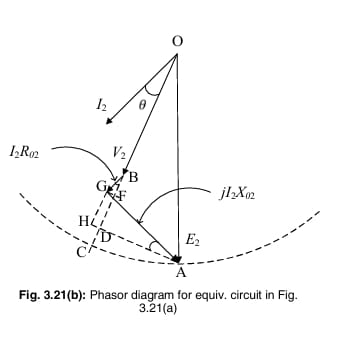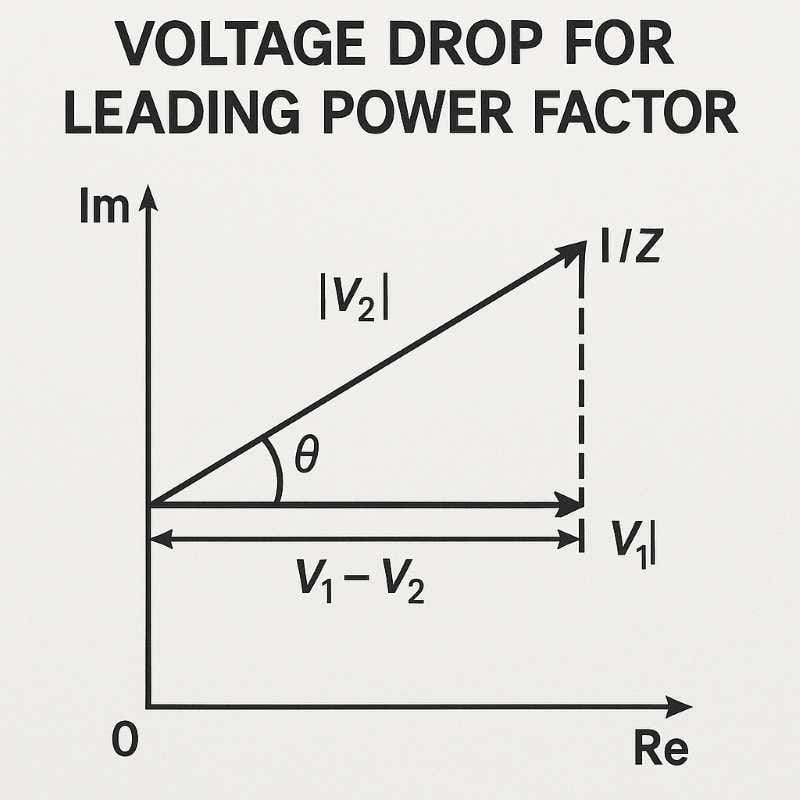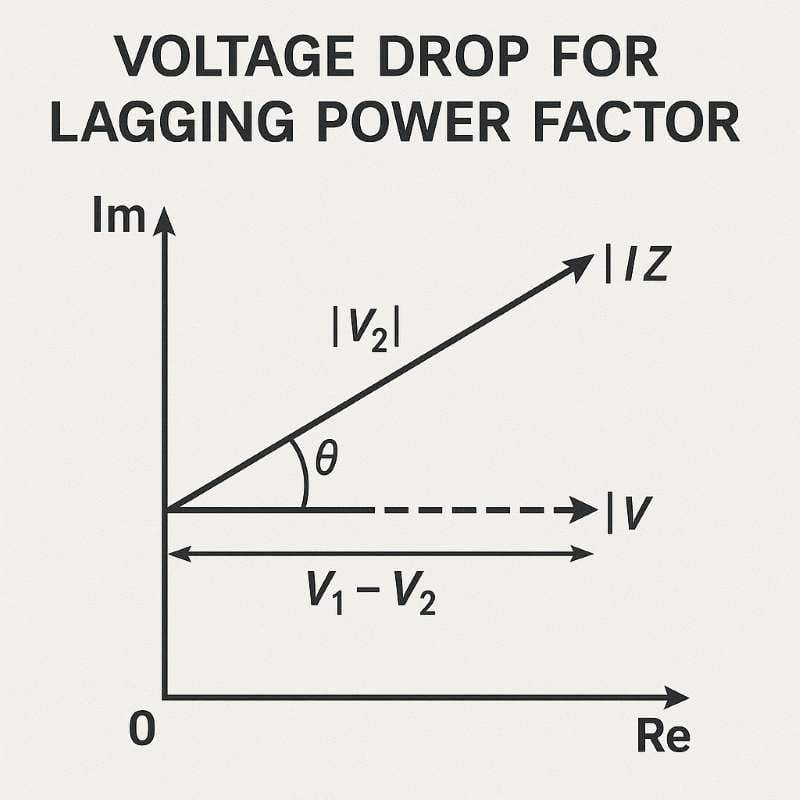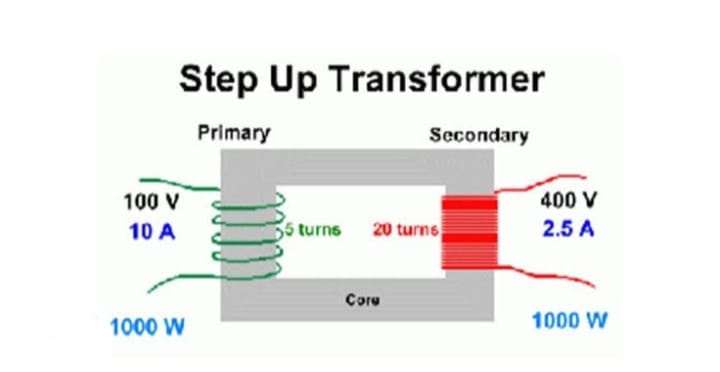Table of Contents
When a transformer is supplied with a fixed applied voltage at its primary winding, the secondary terminal voltage does not always remain constant. If the magnitude or power factor of the load connected to the secondary side changes, a corresponding change in is observed. This change occurs due to the voltage drops across the winding resistances and leakage reactances, a phenomenon known as voltage regulation
What is Voltage Regulation in Transformer?
(Definition)
The Voltage Regulation of a Transformer is the change that occurs in the secondary voltage when the load varies from no-load to full-load, while keeping the primary voltage constant.
In simple terms, when a transformer supplies current to a load, a small voltage drop occurs due to the internal resistance (R) and reactance (X) of the windings. This causes the secondary voltage to decrease. This decrease is known as Voltage Regulation.
🔹 (Mathematical Expression)
% Voltage Regulation = ((VNL – VFL) / VFL) × 100
Where:
- VNL = Secondary voltage at no-load
- VFL = Secondary voltage at full-load
- If the secondary voltage decreases when load is applied → Positive Voltage Regulation
- If the secondary voltage increases when load is applied → Negative Voltage Regulation
🔹 (Interpretation)
Mathematically:

Where:
- = Secondary terminal voltage at no-load
- = Secondary terminal voltage at full-load
Importance of Voltage Regulation
1. Ensures Stable Voltage Supply
Voltage regulation ensures that electrical equipment receives a stable and consistent voltage, even when the load varies.
2. Impacts Motor Performance and Lighting Brightness
Good voltage regulation enables motors to operate smoothly and maintains stable brightness in lighting systems without flicker.
3. Determines Power Quality in Industrial and Domestic Systems
Voltage regulation is a key indicator of a system’s power quality. Poor regulation results in an unstable voltage supply, which affects the system’s reliability.
4. Influences Life Span of Electrical Components
Stable voltage supply increases the lifespan of electrical appliances, while frequent voltage fluctuations can lead to premature failure of components.
voltage regulation in transformer formula
The percentage voltage regulation of a transformer can be derived from its phasor diagram as follows:
The percentage voltage regulation is given by:
% Voltage Regulation = ((E₂ – V₂) / V₂) × 100
Substituting equivalent circuit parameters:
% Voltage Regulation = (%R × cosφ ± %X × sinφ)
Where:
- %R = Percentage resistance drop
- %X = Percentage reactance drop
- φ (phi) = Load power factor angle
- ‘+’ sign → for lagging power factor loads (inductive)
- ‘–’ sign → for leading power factor loads (capacitive)
🔹 Derivation Summary
The voltage drop in a transformer occurs due to:
- Winding resistance (R)
- Leakage reactance (X)
By using vector (phasor) addition, this voltage drop is projected on the output voltage vector.
The trigonometric components of this projection yield the final formula:
% Voltage Regulation = (%R × cosφ ± %X × sinφ)
Example: Numerical Calculation of Voltage Regulation
🔹 Given:
Let the transformer parameters be:
- %R = 2% (Percentage resistance drop)
- %X = 4% (Percentage reactance drop)
- Power Factor (PF) = 0.8 lagging
🔹 Solution:
Using the formula:
% Voltage Regulation = (%R × cosφ ± %X × sinφ)
For 0.8 lagging power factor:
cosφ = 0.8, sinφ = 0.6
% Voltage Regulation = (2 × 0.8) + (4 × 0.6)
= 1.6 + 2.4 = 4.0%
✅ Result: The transformer experiences a 4% voltage drop under full load at 0.8 lagging power factor.
For 0.8 leading power factor:
% Voltage Regulation = (2 × 0.8) − (4 × 0.6)
= 1.6 − 2.4 = −0.8%
✅ Result: The transformer shows a −0.8% voltage regulation, meaning the output voltage slightly increases under leading power factor — this is known as negative voltage regulation.
Phasor Diagram of Transformer
The phasor diagram of a transformer visually represents the phase relationship between voltages and currents under various load conditions. For a lagging power factor load (inductive), it shows the internal voltage drops caused by resistance and leakage reactance.
Voltage Drop for lagging power factor load (inductive)
- Draw an arc with radius OA = |E₂|, taking O as the center.
- Extend OB = |V₂| to intersect the arc at point C (so OA = OC).
- From point A, draw a perpendicular to line OC, meeting at D.

The approximate voltage drop is:
(E₂ – V₂) ≈ (OD – OB)
From geometry:
(E₂ – V₂) = (BF + GH)
Where:
- BF = I₂ × R₀₂ × cosφ
- GH = I₂ × X₀₂ × sinφ
Voltage Drop for lagging power factor load (inductive)
(E₂ – V₂) = I₂ (R₀₂ cosφ + X₀₂ sinφ)
This shows that both resistance (R₀₂) and leakage reactance (X₀₂) cause voltage drop in a transformer.
🔹 Voltage Drop for Leading Power Factor (Capacitive Load)
For a leading power factor (capacitive load), the component due to leakage reactance reduces the total voltage drop.
Hence,
(E₂ – V₂) = I₂ (R₀₂ cosφ – X₀₂ sinφ)
Capacitive loads can improve voltage regulation and may even result in negative regulation.

Combining lagging and Leading Power Factor formula:
(E₂ – V₂) = I₂ (R₀₂ cosφ ± X₀₂ sinφ)
Where:
- ‘+’ sign → Inductive load (lagging)
- ‘–’ sign → Capacitive load (leading)
This general expression allows easy analysis for both types of loads.

🔹 Special Cases: voltage regulation in transformer
- Resistive Load (cosφ = 1, sinφ = 0):
(E₂ – V₂) = I₂ × R₀₂ → Only resistive drop exists. - Inductive Load (Lagging):
Causes a larger positive voltage drop → Positive Regulation. - Capacitive Load (Leading):
May cause voltage rise → Negative Regulation.
Resistance and Reactance Drops formula
It is convenient to express voltage drops in percentage form:
%R = (I₂ × R₀₂ / V₂) × 100
%X = (I₂ × X₀₂ / V₂) × 100
Thus, the simplified regulation formula becomes:
% Voltage Regulation = (%R × cosφ ± %X × sinφ)
Primary and Secondary Side Voltage Regulation in Transformers
Voltage Regulation is one of the most important performance parameters of a transformer. It indicates the change in secondary terminal voltage when the load varies from no-load to full-load, while the primary voltage remains constant. This parameter shows how effectively a transformer maintains a stable output voltage under varying load conditions.

🔍 Key Terms Explained
- E₂ (No-Load Secondary Voltage): The induced EMF in the secondary winding when no load is connected. It is slightly higher than the full-load voltage because no internal voltage drop occurs.
- V₂ (Full-Load Secondary Voltage): The actual voltage available at the secondary terminals when the transformer is under full load. It is less than E₂ due to voltage drops caused by internal resistance (R) and reactance (X) of the windings.
📘 Percentage Voltage Regulation (From Secondary Side)
Voltage regulation represents the difference between no-load and full-load secondary voltages, expressed as a percentage of the full-load voltage.
1️⃣ Upward Regulation
Formula:
% Voltage Regulation = [(E₂ – V₂) / V₂] × 100
- (E₂ – V₂): Represents the internal voltage drop.
- V₂: Normalized with respect to full-load voltage.
It shows how much higher the no-load voltage is compared to the full-load voltage.
2️⃣ Downward Regulation
Sometimes, voltage regulation is expressed with respect to no-load voltage:
% Voltage Regulation = [(E₂ – V₂) / E₂] × 100
Although less commonly used, this form provides a theoretical understanding of internal voltage behavior.
⚙️ Standard Convention
Typically, voltage regulation refers to the drop in voltage from no-load to full-load.
For example, if a transformer has 4% or 5% voltage regulation, it means the full-load voltage is 4–5% less than the no-load voltage.
✅ Practical Meaning
- Positive Regulation: When V₂ < E₂ → Load is inductive or resistive.
- Negative Regulation: When V₂ > E₂ → Load is capacitive (leading power factor).
Thus, voltage regulation indicates how much the input voltage must be adjusted to maintain a constant secondary voltage under changing load conditions.
⚡ Voltage Regulation from the Primary Side
Step 1: Voltage Relations Referred to Primary
According to the transformation ratio (K):
E₂ = K × E₁
V₂ = K × V₁
At no-load, V₁ ≈ E₁, so these relations hold.
Step 2: Definition from Primary Side
% Voltage Regulation = [(E₂ – V₂) / V₂] × 100
This is the same expression, but viewed from the primary side.
Step 3: Practical Definition
In practical applications, the input voltage is adjusted to maintain a constant rated secondary voltage.
Hence, voltage regulation can also be defined as:
“The percentage change required in the primary voltage to keep the secondary voltage constant when the load varies from no-load to full-load.”
Step 4: Extended Formula
If the input voltage changes from V₁ to V₁′ to maintain a constant secondary voltage:
% Voltage Regulation = [(V₁′ – V₁) / V₁] × 100
This shows how much input voltage must be increased or decreased to compensate for internal losses.
Step 5: Effect of Load Power Factor
| Load Type | Current Behavior | Effect on Regulation |
|---|---|---|
| Lagging PF (Inductive) | Current lags voltage | Higher voltage drop → Positive Regulation |
| Leading PF (Capacitive) | Current leads voltage | Voltage rise → Negative Regulation |
| Unity PF (Resistive) | Current in phase with voltage | Moderate voltage drop |
📊 Final Expressions
| Reference | Formula |
| From Secondary Side | %VR = [(E₂ – V₂) / V₂] × 100 |
| From Primary Side | %VR = [(V₁′ – V₁) / V₁] × 100 |
Approximate Equivalent Circuit of Transformer
To simplify voltage drop calculations, engineers use the approximate equivalent circuit of a transformer referred to the secondary side.
In this approximation, the no-load branch (R₀ and X₀) is neglected because it draws very little current and has a minimal effect on the overall voltage drop. This simplification makes it easier to analyze load-related voltage changes accurately.
🧩 Simplified Voltage Equation
The approximate voltage equation for a transformer referred to the secondary side is:
E₂ = V₂ + I₂ (R₀₂ + jX₀₂)
Where:
- E₂ = No-load induced EMF in the secondary winding
- V₂ = Full-load terminal voltage at the secondary
- I₂ = Secondary current
- R₀₂ = R₂ + R′₁ → Equivalent resistance referred to the secondary side
- X₀₂ = X₂ + X′₁ → Equivalent leakage reactance referred to the secondary side
📘 Physical Meaning of the Equation
This equation shows that the induced EMF (E₂) is the vector sum of:
- Secondary terminal voltage (V₂): The actual voltage available to the load.
- Internal voltage drop [I₂ × (R₀₂ + jX₀₂)]: Caused by winding resistance and leakage reactance.
Interpretation:
- The resistive drop (I₂R₀₂) represents copper loss (heat loss) in the windings.
- The reactive drop (I₂X₀₂) represents the phase shift or voltage lag due to magnetic leakage flux.
By combining these two, we can estimate the total internal voltage drop, which helps predict voltage regulation and transformer performance under load.
🧮 Approximate Voltage Drop Formula
The magnitude of the approximate voltage drop (ΔV) can be estimated as:
ΔV ≈ I₂ (R₀₂ cos φ ± X₀₂ sin φ)
Where:
- φ = Load power factor angle
- ‘+’ sign → for Lagging PF (inductive load)
- ‘–’ sign → for Leading PF (capacitive load)
Factors Affecting Voltage Regulation in Transformers
The voltage regulation of a transformer depends on several electrical and physical parameters that determine how the secondary voltage changes under load. The key factors are explained below:
1️⃣ Load Current
- The voltage drop across the internal impedance of the transformer increases with load current.
- Higher load current → greater (I × (R + jX)) drop → poorer voltage regulation.
2️⃣ Power Factor
- The load power factor significantly affects voltage regulation.
- Lagging Power Factor (Inductive Load): Increases voltage drop → positive voltage regulation.
- Leading Power Factor (Capacitive Load): Reduces voltage drop → may cause negative regulation.
3️⃣ Transformer Impedance
- Voltage regulation is directly proportional to the transformer’s impedance (Z = √(R² + X²)).
- Higher impedance → larger voltage drop → poorer voltage regulation.
4️⃣ Winding Resistance
- The resistive component (R) of the winding contributes to I²R losses and affects the total voltage drop.
- Higher resistance → greater copper losses → higher voltage regulation.
5️⃣ Temperature
- As temperature increases, winding resistance also increases, resulting in higher voltage drop under load.
- High operating temperature → poorer voltage regulation.
6️⃣ Core Saturation and Harmonics
- Core saturation at high flux density distorts the voltage waveform.
- Harmonics from non-linear loads affect the current waveform and apparent impedance, leading to irregular voltage regulation behavior.
Negative Voltage Regulation in Transformers
📘 Definition
Negative voltage regulation occurs when the secondary voltage of a transformer at full load exceeds its no-load voltage.
In normal conditions, as load increases, the voltage drops. However, in this case, the secondary terminal voltage rises instead of dropping.
⚡ Reason
Negative voltage regulation occurs when the transformer supplies a leading power factor load (capacitive load). In this condition:
- The reactive voltage drop (I × X) acts in the opposite direction to the resistive voltage drop (I × R).
- As a result, instead of decreasing, the total voltage on the secondary side increases.
Mathematically:
% Regulation = ((E₂ – V₂) / V₂) × 100
If V₂ > E₂, then the voltage regulation is negative.
💡 Practical Examples
- Capacitor Banks: Used for power factor correction, they often produce a leading current, which causes negative voltage regulation.
- Unloaded or lightly loaded transmission lines: Exhibit capacitive behavior, resulting in a voltage rise on the receiving end.
🔧 Prevention and Design Considerations
- Maintain load balancing to avoid excessive leading power factor.
- When adding large capacitor banks, use reactors or inductive compensation.
- Transformer design should account for potential voltage rise under light or capacitive loads.
Real-World Case Study: Voltage Regulation of a Distribution Transformer
Given Data:
Transformer rating = 100 kVA, 11 kV/415 V
Percentage resistance, %R = 1.8%
Percentage reactance, %X = 3.2%
Case 1: At 0.9 Lagging Power Factor
Using the general voltage regulation formula:
% Regulation = (%R × cosφ + %X × sinφ)
Substituting values:
= (1.8 × 0.9) + (3.2 × 0.435)
= 1.62 + 1.39
= ≈ 3.0%
✅ The transformer experiences about a 3% voltage drop under inductive (lagging PF) load.
Case 2: At 0.9 Leading Power Factor
% Regulation = (%R × cosφ – %X × sinφ)
Substituting values:
= (1.8 × 0.9) – (3.2 × 0.435)
= 1.62 – 1.39
= ≈ 0.23%
✅ The voltage drop is almost negligible (close to zero), indicating very good regulation under capacitive (leading PF) load.
Methods to Improve Voltage Regulation in Transformers
To improve the voltage regulation of transformers, several practical and design-based techniques are implemented. These methods help maintain stable voltage and improve power quality under varying load conditions.
1️⃣ Tap-Changing Transformers
On-Load Tap Changer (OLTC):
- Automatically changes the transformer winding ratio during operation.
- Maintains almost constant output voltage despite fluctuations in supply or load.
Off-Load Tap Changer:
- Used when voltage variations are small.
- Tap settings are manually adjusted when the transformer is de-energized.
✅ These tap changers allow fine-tuning of secondary voltage according to load and supply conditions.
2️⃣ Automatic Voltage Regulator (AVR)
- Continuously monitors the transformer’s output voltage.
- Maintains stable voltage by adjusting excitation or switching circuits.
- Ensures consumers receive a stable and high-quality power supply, regardless of load or input voltage changes.
3️⃣ Capacitor Banks and VAR Compensation
- Installing capacitor banks reduces the reactive power demand.
- Decreases the voltage drop caused by transformer reactance, thereby improving voltage regulation.
- Highly effective in industrial systems where inductive loads are dominant.
4️⃣ Reactive Power Management
- Advanced devices like STATCOM, SVC, and other FACTS systems control reactive power in real time.
- These technologies improve power factor and reduce voltage fluctuations.
5️⃣ Proper Transformer Design
For better voltage regulation, transformer design should ensure:
- Low-resistance windings to minimize I²R losses.
- Optimized core and coil geometry to reduce leakage reactance.
- High-quality core materials to lower magnetic losses and improve overall efficiency.
Testing Voltage Regulation in Transformer
To determine the voltage regulation of a transformer practically, two standard tests are performed — the Open-Circuit Test (O.C. Test) and the Short-Circuit Test (S.C. Test).
1️⃣ Open-Circuit Test (O.C. Test)
Purpose:
Conducted to determine core (iron) losses and magnetizing current.
Procedure:
- The low-voltage winding is energized with the rated voltage, while the high-voltage winding is kept open.
Measurements Taken:
- Input Voltage (V₁)
- No-load Current (I₀)
- Power Input (W₀)
From this test:
Core Losses (P₀) = W₀
2️⃣ Short-Circuit Test (S.C. Test)
Purpose:
Conducted to determine copper losses and the equivalent impedance of the transformer.
Procedure:
- The high-voltage winding is supplied with just enough voltage to circulate full-load current in the short-circuited low-voltage winding.
Measurements Taken:
- Short-Circuit Voltage (Vₛ꜀)
- Short-Circuit Current (Iₛ꜀)
- Power Input (Wₛ꜀)
From this test:
- Copper Losses (P꜀ᵤ) = Wₛ꜀
- Equivalent Impedance (Zₑᵩ) = Vₛ꜀ / Iₛ꜀
- Equivalent Resistance (Rₑᵩ) = P꜀ᵤ / Iₛ꜀²
- Equivalent Reactance (Xₑᵩ) = √(Zₑᵩ² – Rₑᵩ²)
3️⃣ Calculation of Voltage Regulation
After obtaining equivalent circuit parameters from the tests, the percentage voltage regulation is calculated using:
% Voltage Regulation = (%R × cosφ ± %X × sinφ)
Where:
- ‘+’ sign → for lagging power factor (inductive load)
- ‘–’ sign → for leading power factor (capacitive load)
Standards and References
1️⃣ IEC 60076 – Power Transformers
- Published by the International Electrotechnical Commission (IEC).
- Provides comprehensive guidelines on design, testing, and operational performance of power transformers.
Key Points Covered:
- Load performance and voltage regulation.
- Efficiency and permissible limits.
- Testing procedures related to temperature rise, losses, and impedance.
📗 2️⃣ IS 1180 (Part 1) – Indian Standard for Distribution Transformers
- Published by the Bureau of Indian Standards (BIS).
- Specifies the technical requirements for outdoor-type oil-immersed distribution transformers (up to 2500 kVA and 33 kV class).
Includes Parameters Such As:
- Voltage regulation limits.
- Percentage impedance (% Impedance).
- Efficiency and temperature rise criteria.
- Performance under different load conditions.
📙 3️⃣ IEEE C57.110 – Recommended Practice for Establishing Transformer Capability When Supplying Nonsinusoidal Load Currents
- Issued by the Institute of Electrical and Electronics Engineers (IEEE).
- Provides methods for calculating derating factors considering the impact of harmonic distortion on transformers.
Key Considerations:
- Effects of nonsinusoidal loads on transformer losses and heating.
- Impact on voltage regulation and efficiency.
- Influence on transformer life and reliability.
Applications & Real-World Importance of Voltage Regulation
Voltage regulation is not merely a theoretical concept — it is a crucial performance parameter that ensures reliability, safety, and efficiency across the entire power system. It plays a vital role in maintaining stable voltage levels under varying load conditions. Below are its major applications and real-world uses.
1️⃣ Distribution Transformers (Lighting and Domestic Loads)
Distribution transformers supply electrical power to lighting circuits, appliances, and sensitive electronics in residential and commercial systems.
Effects of Poor Voltage Regulation:
- Flickering or dim lighting.
- Malfunction or damage to electronic devices.
Good Voltage Regulation Ensures:
- Consistent illumination.
- Safe and reliable operation.
📘 Example: Street lighting systems connected to distribution transformers function efficiently only when voltage levels remain within prescribed limits.
2️⃣ Industrial Applications (Motors and Welding Transformers)
Industrial systems rely on induction motors, synchronous machines, and welding transformers.
Effects of Poor Voltage Regulation:
- Excessive motor heating and insulation failure.
- Reduced starting torque and efficiency.
- Unstable welding arc leading to poor weld quality.
Good Voltage Regulation Ensures:
- Higher productivity.
- Longer equipment lifespan.
- Superior industrial output quality.
3️⃣ Power Systems and Grid Stability
In large-scale power systems, voltage regulation directly affects grid stability and reliability.
Problems Caused by Poor Regulation:
- Sudden load changes lead to voltage drops, causing instability or even blackouts.
Proper Voltage Regulation Ensures:
- Smooth integration of renewable energy sources.
- Balanced power supply between urban and rural regions.
- Voltage stability, reducing the chances of blackouts or brownouts.
4️⃣ Transformer Procurement and Testing
Voltage regulation is a key technical specification during transformer procurement. It helps utilities evaluate transformer performance under various load conditions.
During Factory Acceptance Testing (FAT):
- Voltage regulation is measured to verify compliance with IEC, IS, and IEEE standards.
✅ Transformers with better voltage regulation are considered more stable and reliable.
5️⃣ Consumer-End Benefits
Advantages of Good Voltage Regulation in Transformer:
- Reduced voltage fluctuations in homes and offices.
- Increased lifespan of devices like computers, refrigerators, and LED lights.
- Improved overall power quality and consumer satisfaction.
FAQ
What is an acceptable % voltage regulation for a distribution transformer?
A distribution transformer generally has a regulation between ±3% to ±5%, depending on its size and design. Good regulation ensures stable lighting loads, fewer voltage fluctuations, and better consumer satisfaction.
Why can voltage regulation be negative?
Voltage regulation becomes negative when the secondary voltage at full load (V₂) is higher than the no-load induced EMF (E₂). This usually happens under a leading power factor load (capacitive) where reactive effects cause the voltage to rise.
How does power factor affect transformer regulation?
At lagging power factor (inductive loads): Voltage drop increases, giving positive regulation.
At leading power factor (capacitive loads): Voltage may rise, leading to negative regulation.
At unity power factor (purely resistive): Drop depends only on copper resistance.
This shows that power factor correction is a key strategy for maintaining good regulation.Is lower voltage regulation always better?
Yes, in most cases, lower regulation is preferred as it indicates the transformer maintains nearly constant voltage under load. However, extremely low or negative values are not always desirable, since they may signal overcompensation or instability in certain operating conditions.
Why do engineers test voltage regulation before procurement?
Voltage regulation tests are part of acceptance and performance checks for transformers. They ensure that the unit can deliver stable secondary voltage under varying loads, making it suitable for distribution networks, industrial plants, and grid applications.

